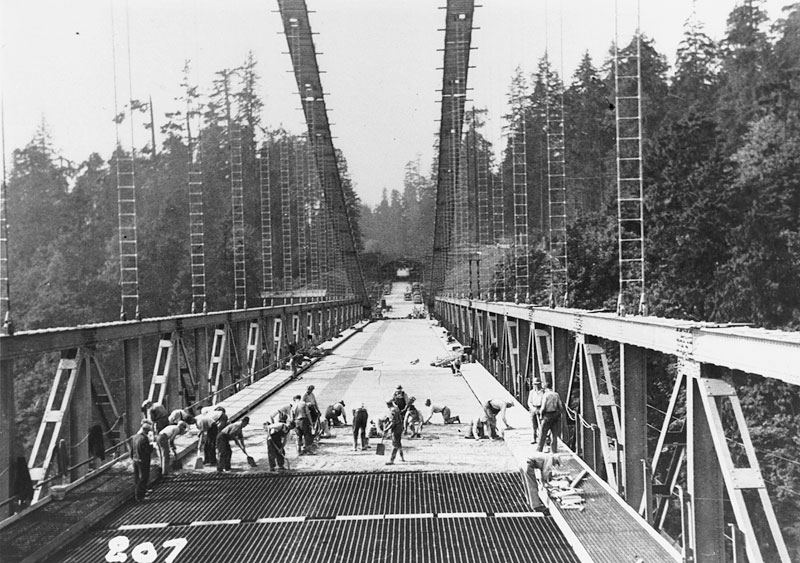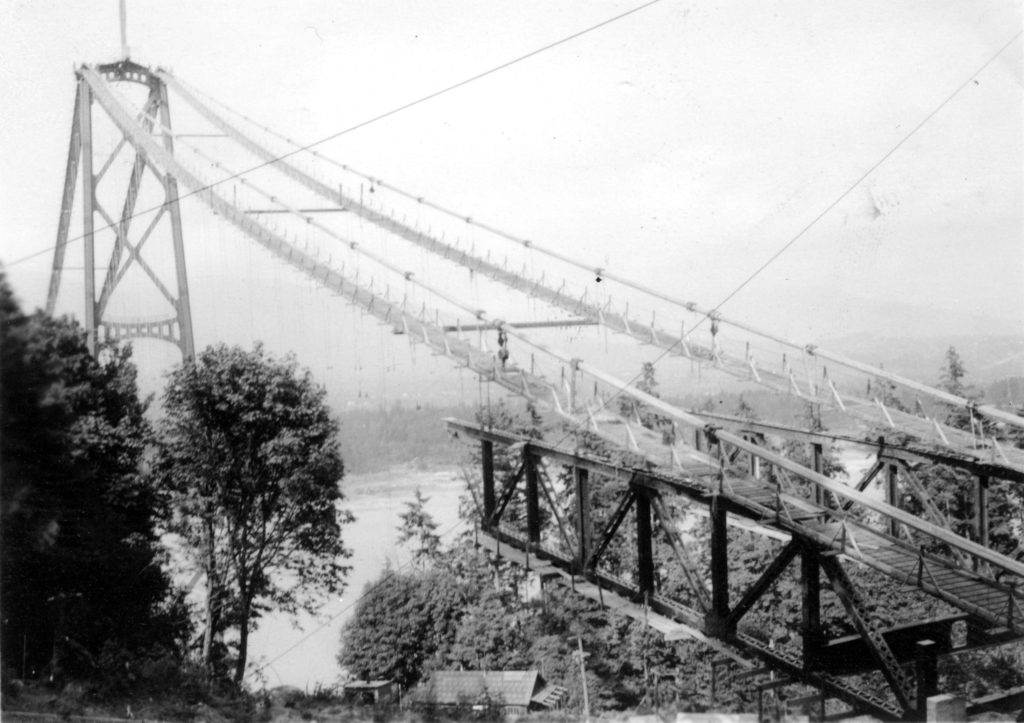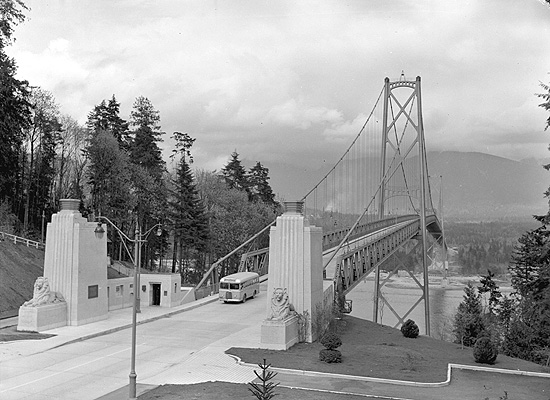We Recommend:
Bach Steel - Experts at historic truss bridge restoration.
BridgeHunter.com Phase 1 is released to the public! - Visit Now
Lions Gate Bridge
First Narrows Bridge

Primary Photographer(s): C. Hanchey, CC BY-NC 2.0, flickr.com/photos/21953562@N07/
Bridge Documented: August 10, 2010
Vancouver and West Vancouver: Greater Vancouver District, British Columbia: Canada
1938 By Builder/Contractor: Dominion Bridge Company of Montréal, Québec and Engineer/Design: Monsarrat and Pratley of Montréal, Québec (Charles Nicholas Monsarrat and Philip Louis Pratley)
2001
1,552.0 Feet (473 Meters)
5,981.0 Feet (1823 Meters)
Not Available
3 Main Span(s)
Not Applicable

View Information About HSR Ratings
Bridge Documentation
This monumental and famous bridge retains its landmark status, despite severe alteration of the design of the bridge through loss of the original stiffening truss. The use of pony truss stiffening was a trademark and key feature of suspension bridges designed by the Canadian firm of Monsarrat and Pratley. In 2000-2001 the entire original stiffening truss system was demolished and replaced with a modern structure, that looks like an extremely shallow deck truss. The loss of original material as well as the replacement of the original design stiffening truss with an unusual design that looks nothing like the original engineer's design is a major alteration to this bridge and severely reduces its historic integrity. Also, another trademark of Monsarrat and Pratley, which was to use unusual paired suspenders with spacers was lost. The bridge still has unusual paired suspenders, but the spacers were not replaced. The spacers gave the bridge an unusual appearance. Please see the Pont de l'Île-d'Orléans Bridge as it is one of the only unaltered surviving Monsarrat and Pratley suspension bridges. Despite the severe alteration of this bridge and loss of probably over 50 percent of the original steel on the bridge, the towers remain original and the famous lion sculptures at the ends of the bridge remain. Despite alteration, due to its monumental size and importance to the region, the bridge is a designated National Historic Site of Canada. Contractors for the bridge were Dominion Bridge Company (superstructure) Hamilton and Chambers (superstructure) Stuart Cameron and Company (approach viaducts).
Above: Historical photo showing bridge construction.
Above: Historical photo showing bridge construction.
Above: Historical photo showing bridge construction.
Above: Historical photo of bridge showing original stiffening trusses.
Above: Historical photo of bridge showing original stiffening trusses.
Above: Historical photo of bridge showing original stiffening trusses.
Information and Findings From Canada's Historic PlacesDescription of Historic Place Located in Vancouver, the Lions Gate Bridge National Historic Site of Canada is the longest suspension bridge in Western Canada with a total length (including approach spans) of 1517 metres. The bridge has three traffic lanes, an electronic signage system and a pedestrian and cyclist sidewalk on either side of the deck. It serves as a major transportation link for communities throughout the region on both sides of Burrard Inlet. The site includes the south entrance to the bridge that emerges from Stanley Park National Historic Site of Canada, near Prospect, the main span, which is supported by twin towers, and the viaduct on the north shore located in a land corridor that crosses Capilano Indian Reserve. Heritage Value The Lions Gate Bridge was designated a National
Historic Site of Canada in 2004 because: Character-Defining Elements Key elements that define the heritage character of
the Lions Gate Bridge include: Heritage Designation and Type: Yes |
![]()
Photo Galleries and Videos: Lions Gate Bridge
Bridge Photo-Documentation
Original / Full Size PhotosA collection of overview and detail photos. This gallery offers photos in the highest available resolution and file size in a touch-friendly popup viewer.
Alternatively, Browse Without Using Viewer
![]()
Bridge Photo-Documentation
Mobile Optimized PhotosA collection of overview and detail photos. This gallery features data-friendly, fast-loading photos in a touch-friendly popup viewer.
Alternatively, Browse Without Using Viewer
![]()
Maps and Links: Lions Gate Bridge
Coordinates (Latitude, Longitude):
Search For Additional Bridge Listings:
Additional Maps:
Google Streetview (If Available)
GeoHack (Additional Links and Coordinates)
Apple Maps (Via DuckDuckGo Search)
Apple Maps (Apple devices only)
Android: Open Location In Your Map or GPS App
Flickr Gallery (Find Nearby Photos)
Wikimedia Commons (Find Nearby Photos)
Directions Via Sygic For Android
Directions Via Sygic For iOS and Android Dolphin Browser







